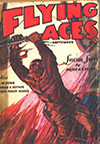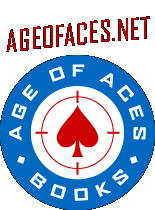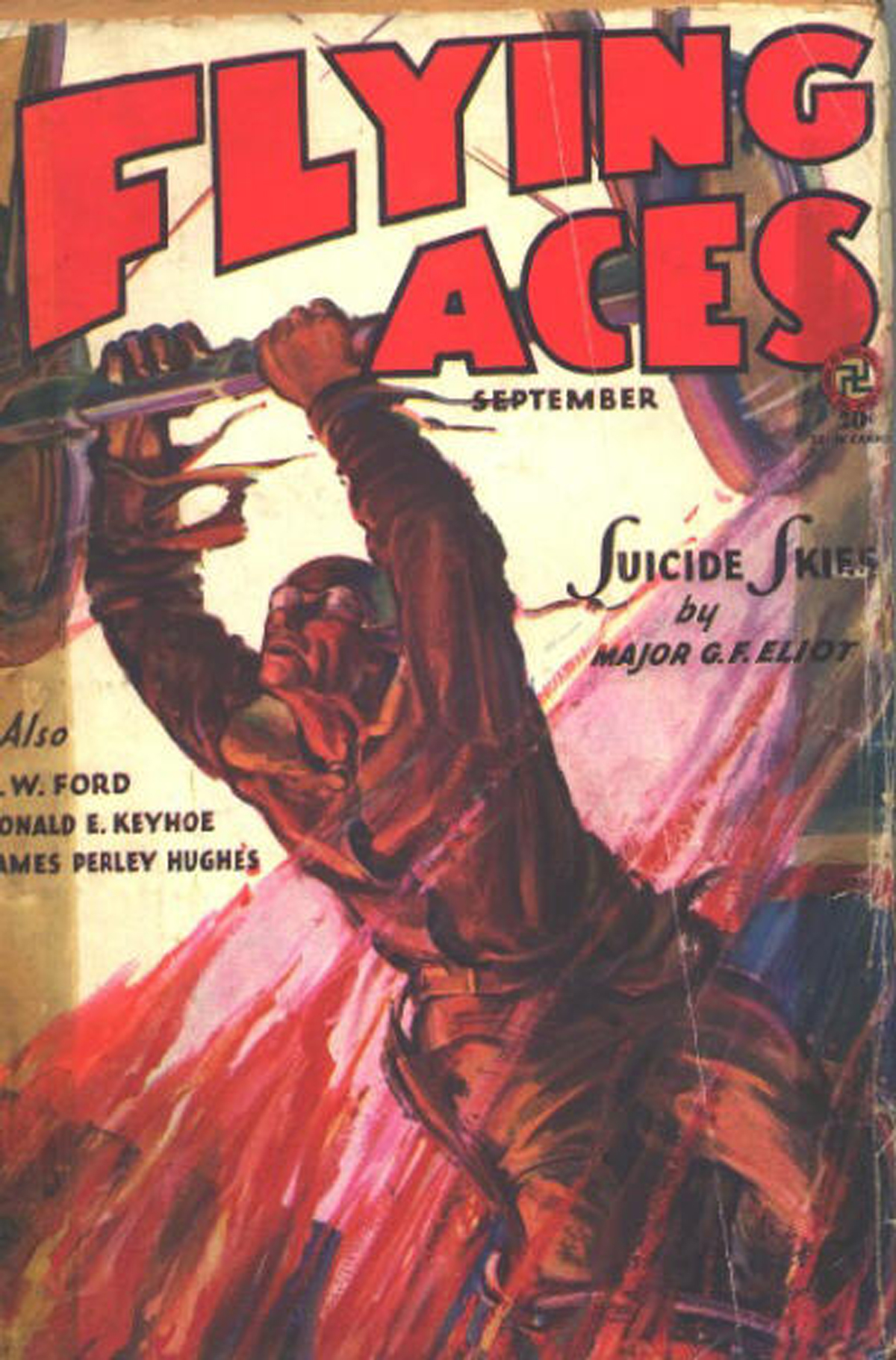HERE, at Age of Aces Books, we have featured a lot of great aviation covers by Frederick Blakeslee (Dare-Devil Aces, Battle Aces and Battle Birds), Eugene M. Frandzen (Sky Fighters and Lone Eagle), Paul Bissell (Flying Aces) and C.B. Mayshark (Flying Aces). You can add to that list J.W. Scott! Scott painted covers for practically every genre of pulp—sports, western, detective, science fiction and aviation. Most notable of his aviation covers are the ones he did for Western Fiction Publishing’s Sky Devils. The title only ran for seven issues. Scott was very adept at capturing people, so his aviation covers center on the pilots and gunners in the planes rather than the planes themselves for the most part. The issues contained no stories for these covers like other titles we’ve featured, but Scott’s magnificent work was just too good to not feature! And besides, he captures the action so well, you can imagine the story that goes with the cover he’s painted.
Here are his first two covers for Sky Devils—those for March and July 1938!

Sky Devils, March 1938 by J.W. Scott

Sky Devils, July 1938 by J.W. Scott
As a bonus, here is David Saunder’s biography of J.W. Scott from his extensive Field Guide to Wild American Pulp Artists website!

J. W. SCOTT
(1907-1987)
John Walter Scott, Jr. was born on December 1, 1907 in Camden, New Jersey. His father of the same name was a second generation immigrant from Scotland, and was a draftsman at the Camden Shipyard. His mother was Helen L. Scott, who was of Irish ancestry. They lived at 7 Wood Street, which was one block from the busy riverfront piers. He and his father were avid fishermen.
During the Great War his father rejoined the U.S.Army and attained the rank of Captain before dying in 1919.
His mother took a job at the La France Tapestry Mill in Philadelphia, and in 1923 at age fifteen, he left school and began to work at the same mill.
The mill operator offered free night school classes in various facets of mill work to his child laborers, including design at the La France Art Institute.
In 1930 he finished his art training and began to pursue a career in freelance illustration. He worked under the name “J.W. Scott” out of emulation for the well-known pulp artist “H.W. Scott” as well as to capitalize on any resultant confusion over his professional status.
In 1932 and age twenty-five, he moved to 390 First Avenue in New York City.
His first published pulp cover appeared on the July 9, 1932 issue of Street & Smith’s Wild West Weekly.
He sold freelance pulp covers to All Star Fiction, Best Western, Complete Western Book, Detective Short Stories, Future Fiction, Ka-Zar, Lone Eagle, Marvel Science Stories, Mystery Tales, Quick-Trigger Western, Real Sports, Star Detective, Star Sports, Top-Notch Western, Two-Gun Western, Western Fiction, Uncanny Tales, Western Novel and Short Stories.
By 1938 he joined an advertising agency and began to find work in slick magazines. He became friends with R.G. Harris and other New Rochelle illustrators. In the Fall he married Eleanor Snyder, a banker’s daughter and socialite, but the marriage only lasted one year. There were no children.
During WWII he served in U.S. Army Corps of Combat Engineers. His detailed field drawings were sent by his Lieutenant to the editors of YANK Magazine, and he was soon invited to work on their art staff. He eventually wrote several articles and was promoted to the editorial staff.
After the war Scott found slick magazine assignments with Coronet, Elks, This Week, and Woman’s Day.
In 1946 he married Flavia Bensing. She was also an artist, as well as the daughter of an artist, Frank C. Bensing. They moved to Ridgefield, Connecticut, where they raised two daughters.
In the 1950s he began to work for men’s adventure magazines, such as Argosy, True, and Sports Afield. He continued to produce illustrations for Sports Afield for almost two decades.
In the 1960s he was commissioned to paint several impressive murals for The Church of Latter Day Saints and The Petroleum Museum of Midland Texas.
In his final years Scott worked on easel paintings of the Old West.
According to the artist, “I paint the pictures I am interested in painting. Much of contemporary art is about people who think they are IN. The quickest way to lose yourself is to lose your individuality. The important thing is to be yourself and forget about being IN.”
John Scott died in the Danbury Hospital at the age of seventy-nine on October 20, 1987.

Check out David Saunder’s page for J.W. Scott at his excellent Field Guide to Wild American Pulp Artists site for more great examples of Scott’s work. And check back in two weeks for two more of Scott’s covers for Sky Devils magazine!
 A TENSE dramatic moment is pictured in this month’s cover—the daring rescue of a Yank flyer by his buddy. In the dogfight which has just taken place, the gas tank in the Yank’s plane was punctured by Spandau bullets, and his plane caught fire. As the flames spread, threatening to envelope his body and send him down in a fiery dive of death, another American plane swooped down. In it was his buddy. Almost on top of the burning plane he came, and near enough so that the other Yank could grasp his landing gear and pull himself up—to safety.
A TENSE dramatic moment is pictured in this month’s cover—the daring rescue of a Yank flyer by his buddy. In the dogfight which has just taken place, the gas tank in the Yank’s plane was punctured by Spandau bullets, and his plane caught fire. As the flames spread, threatening to envelope his body and send him down in a fiery dive of death, another American plane swooped down. In it was his buddy. Almost on top of the burning plane he came, and near enough so that the other Yank could grasp his landing gear and pull himself up—to safety.













